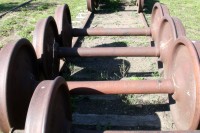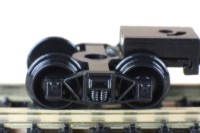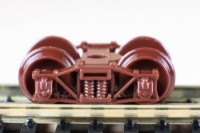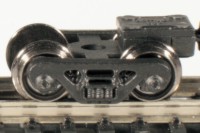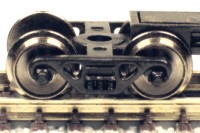Z Scale Truck and Coupler Review, Appendix A:
Freight Car Truck Reference
Many hundreds of different truck styles have come into existence since the birth of railroading, and so the modeling world has little hope of being comprehensive—least of all in Z scale. But several types have emerged as the most popular; also, a number of variations on certain types are close enough that "generic" models can adequately represent several prototypes.
The most common truck types from the early 1900s were Archbar and Andrews. Archbar trucks comprised numerous pressed steel components that were bolted together, thus requiring considerable maintenance. They were banned from interchange service by 1940. By the 1920s, the Bettendorf Company had introduced the Andrews truck, which had a cast steel side frame design that required much less maintenance, yet accepted the journal boxes (wheel bearings) from Archbar trucks.
Not long after introducing cast steel side frames, the Bettendorf Company developed a version with integral journal boxes. This design was adopted by the American Railway Association (later the Association of American Railroads) as a standard. This "Type Y" design was licensed to many manufacturers, resulting in numerous variations on what has since become known generically (though incorrectly) as the "Bettendorf" truck. The most common variants include the AAR U-section, double-truss, Barber S-2 stabilized, and A-3 ride-control 50-ton trucks.
The next major innovation in truck design was the roller bearing, which replaced the maintenance-intensive solid journal (or "friction bearing," as only modelers call it). With better rolling characteristics and vastly reduced maintenance, roller bearing trucks got their start as early as the 30s on passenger cars, but due to their higher cost did not see widespread use on freight until the 50s. New cars built after 1966 were required to have roller bearing trucks, and solid journal trucks were banned from interchange service between 1980 and 1994 (depending on your source of information). Some solid journal trucks were retrofitted with roller bearings to save money, but these were also banned by 1995. Although many roller bearing truck designs have emerged, the ones most often seen are the ASF (American Steel Foundry) 70-ton Ride Control and 100-ton Barber S-2 stabilized trucks.
A few notes on wheels: The backs of wheels on Archbar, Andrews and other earlier trucks would typically be ribbed (although it's highly doubtful we'll ever see such a thing modeled in Z scale). Ribbed-back wheels were cast iron; the ribs dissipated heat generated by braking. By the 50s smooth-back cast steel wheels were replacing them, and they were banned from interchange service in 1970.
Wheels come in many sizes; although there are exceptions, in general the wheel size corresponds to the rated load of the truck. 70-, 100- and 125-ton trucks will have 33-, 36- and 38-inch wheels, respectively. There were some 100-ton Type Y ("Bettendorf") trucks, but the vast majority of them were 70-ton, so they'll have 33-inch wheels. The most commonly-seen roller bearing trucks are 70- and 100-ton; a crude spotting rule to determine the difference is the number of visible springs: 70-ton trucks have two, and 100-ton have three (although again there will be exceptions).

Drawing of a typical Type "Y" (Bettendorf-type) freight truck.
Aside from having a wide range of cosmetic quality, how do the model trucks stack up against the real thing in terms of accuracy? The table below provides the numbers—and possibly some surprises.
|
|||||||||||||||||||||||||||||||||||||||||||||||||||||||
The photos along the right present the most accurate trucks currently available in Z—and this assumes that one is willing to swap out wheelsets to produce some of them.
It seems odd that Micro-Trains trucks should be so far off, considering the fidelity of the details; the only explanation I can come up with is that they had to be made shorter in order to clear freight car stirrups and caboose steps. It's a shame, because Micro-Trains' tooling has no peer. But to be honest, once you've seen correctly-sized trucks on your rolling stock, the M-Ts start to look like "dwarfs," hence the only M-T trucks that make it into this list are their Archbars—and even then things are not straightforward.
Pre-1900s Archbars have a 60-inch wheelbase—appropriate for cars such as Father Nature's 33-foot wooden refrigerators, as an example. Stock Micro-Trains Z scale Archbar trucks represent these quite well. But the more commonly-seen Archbar trucks (1900-1920) have a 66-inch wheelbase. Guess what? The Micro-Trains #961 Nn3 Diamond Archbar Trucks have a 66-inch wheelbase! So, using their Nn3 trucks in Z scale would accurately represent these Archbars. Note, however, that these trucks come with 36-inch (in Z scale) wheels, so they'd have to be replaced with 33-inch wheels (preferably the "rust" variety—black wheels in rust trucks looks odd), and they do not come with mounted couplers.
Meanwhile, AZL has the correct wheelbases on their two trucks, even if their proportions are off—in particular, their roller bearing truck looks "squashed," and the details are indistinct. As for getting the right wheels, things are a bit of a kluge. Their Bettendorf-type trucks have 36-inch wheels instead of 33. And up until recently, their roller bearing trucks had 33-inch wheels instead of 36. To get a correct Bettendorf truck, you'd need to swap out the wheels from their older roller bearing trucks, because going forward they'll have the newer 36-inch wheels, so now their roller bearing trucks at least have it right.
Full Throttle's 66-inch wheelbase falls within the range for a Type "Y" truck. Most notably, Full Throttle has the best overall proportions, particularly the truck height. This was accomplished by raising the side frames above the center plate—which is exactly the way real trucks are made. For modelers looking for accurate Bettendorf-type trucks "out of the box," Full Throttle is the product of choice by a wide margin, in my opinion.
Handy prototype coupler height reference: "...232.2 Drawbars; standard height. Except on cars specified in the proviso in section 6 of the Safety Appliance Act of March 2, 1893 (sec. 6, 27 Stat. 532, 45 U.S.C. 6) as the same was amended April 1, 1896 (29 Stat. 85; 45 heretofore designated in compliance with law is hereby modified and changed in the manner hereinafter prescribed, to wit: The maximum height of drawbars for freight cars measured perpendicularly from the level of the tops of rails to the centers of drawbars for standard-gauge railroads in the United States subject to said act shall be 34-1/2 inches, and the minimum height of drawbars for freight cars on such standard-gauge railroads measured in the same manner shall be 31-1/2 inches..."
Copyright © 2007-2013 by David K. Smith. All Rights Reserved.









